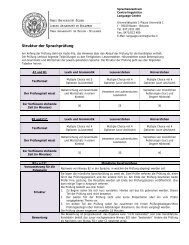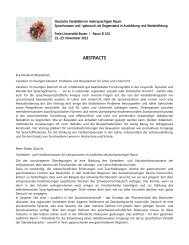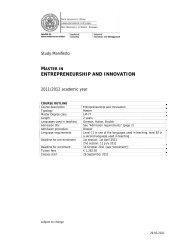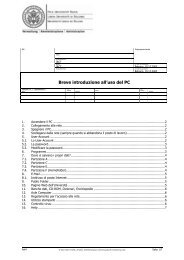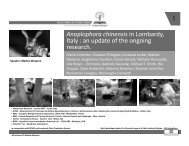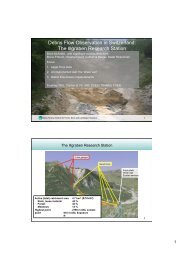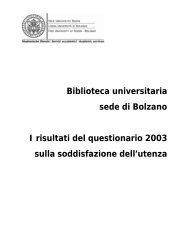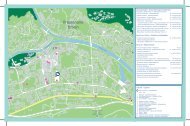Debris-flow monitoring in Japan
Debris-flow monitoring in Japan
Debris-flow monitoring in Japan
Create successful ePaper yourself
Turn your PDF publications into a flip-book with our unique Google optimized e-Paper software.
Bolzano 2012 Workshop on Monitor<strong>in</strong>g Bedload and <strong>Debris</strong> Flows<br />
<strong>Debris</strong>-<strong>flow</strong> <strong>monitor<strong>in</strong>g</strong> <strong>in</strong> <strong>Japan</strong><br />
Hiroshi SUWA<br />
Center for Spatial Information Science, University of Tokyo,<br />
and Research Center for Disaster Mitigation of Urban Cultural Heritage,<br />
Ritsumeikan University<br />
suwa@csis.u-tokyo.ac.jp<br />
Photo: September 4, 2011 <strong>Debris</strong> <strong>flow</strong> disaster at Nachi Katsuura, Wakayama, <strong>Japan</strong>
More than 70 % of ma<strong>in</strong><br />
islands of <strong>Japan</strong> are<br />
composed of steep mounta<strong>in</strong>s<br />
that are be<strong>in</strong>g produced by the<br />
active tectonics and blessed<br />
with hazards of earthquakes,<br />
volcanic activities, ra<strong>in</strong>storms<br />
and so on.<br />
We <strong>Japan</strong>ese suffers serious<br />
disasters from these hazards.<br />
Landslides and debris <strong>flow</strong>s<br />
br<strong>in</strong>g us significant damages<br />
and great losses of lives every<br />
year.
<strong>Debris</strong>-<strong>flow</strong> disasters <strong>in</strong> the late 60’s<br />
A succession of serious debris-<strong>flow</strong><br />
disasters <strong>in</strong> <strong>Japan</strong> <strong>in</strong> the late 60’s<br />
forced us to promote studies on debris<br />
<strong>flow</strong>.<br />
For <strong>in</strong>stance, the 17 August 1968<br />
heavy ra<strong>in</strong>storm <strong>in</strong>duced a debris <strong>flow</strong>.<br />
It <strong>in</strong>corporated two buses on a highway<br />
and claimed 104 lives of passengers.<br />
At that time, this author was an<br />
undergraduate student.<br />
This disaster forced him jo<strong>in</strong> a study<br />
group of DPRI of Kyoto University<br />
which just started a debris-<strong>flow</strong><br />
<strong>monitor<strong>in</strong>g</strong> at Mount Yakedake <strong>in</strong> 1970.<br />
The slope of this debris <strong>flow</strong> that caused the<br />
17 August 1968 Hida River Bus Accident
<strong>Debris</strong>-<strong>flow</strong> <strong>monitor<strong>in</strong>g</strong> by DPRI, Kyoto Univ.<br />
<strong>Debris</strong>-<strong>flow</strong> <strong>monitor<strong>in</strong>g</strong> has been conducted at the torrents where<br />
debris-<strong>flow</strong> frequency is high. Four slopes are at volcanoes.<br />
• 1970-now: Kamikamihorizawa torrent of Mount Yakdake, <strong>Japan</strong><br />
(with Matsumoto Sabo Erosion Control Office) (Volcano)<br />
• 1991-1998: Mizunashigawa torrent of Mount Unzen, <strong>Japan</strong><br />
(Volcano)<br />
• 1991-1998 Jiang-jia Gou torrent <strong>in</strong> Yunnan, Ch<strong>in</strong>a (with Chendu<br />
Institute of Mounta<strong>in</strong> Hazards and Environments) (Sedimentary rock)<br />
• 1991-1993 Gu-xian Gou torrent <strong>in</strong> Xīzàng, Ch<strong>in</strong>a (with Lanzhou<br />
Institute of Glaciology and Geocryology) (Metamorphic rock)<br />
• 1991-1995 Kali Bebeng torrent of Mount Merapi, Indonesia<br />
(with Research Institute for Water Resources Development) (Volcano)<br />
• 2000-2006 Kali Curah Lengkong torrent of Mount Semeru, Indonesia<br />
(with Dr. Lavigne, F., Prof. Thouret, J-P., and VSI) (Volcano)<br />
• 2000 Hushe River <strong>in</strong> Karakorum, Pakistan (Metamorphic rock)
Hushe River,<br />
Karakorum<br />
Jiang-jia Gou,<br />
Yunnan<br />
Kamikamihorizawa<br />
torrent,<br />
Mt. Yakedake<br />
Gu-xian Gou,<br />
Xizang<br />
Bebeng R.<br />
Mt Merapi,<br />
Java Island<br />
Mizunashigawa<br />
torrent, Mt. Unzen<br />
Curah Lengkong<br />
R. Mt. Semeru,<br />
Java Island
Monitor<strong>in</strong>g at Mount Yakedake<br />
L<strong>in</strong>k to video 1
Topics from the synthesis of the <strong>monitor<strong>in</strong>g</strong><br />
1)Rheological type<br />
2)Pulsation<br />
3)Mass and boulder focus<strong>in</strong>g<br />
4)Ground tremor and sound<br />
5) Test of moderation of debris-<strong>flow</strong><br />
discharge
RHEOLOGICAL TYPE<br />
A stony type-debris <strong>flow</strong> is<br />
dom<strong>in</strong>ant at the torrents of<br />
active volcanoes,<br />
while the turbulent type at<br />
Fushe River (metamorphic<br />
rock),<br />
and the viscous type at<br />
Jiang-jia Gou torrent<br />
(sedimentary rock).
RHEOLOGICAL TYPE<br />
Astonytype-debris <strong>flow</strong> is<br />
dom<strong>in</strong>ant at the torrents of<br />
active volcanoes,<br />
while the turbulent type at<br />
Fushe River (metamorphic<br />
rock),<br />
and the viscous type at<br />
Jiangjia-gou torrent<br />
(sedimentary rock).<br />
= f (rock type, water availability,<br />
geomorphic aspects of torrent, etc)<br />
(Turbulent)<br />
Relative height<br />
(Viscous)<br />
Relative height=<strong>flow</strong> depth/median diameter of solid particle<br />
(Stony)<br />
After Takahashi (2000)
PULSATION<br />
<strong>Debris</strong> <strong>flow</strong>s are monitored<br />
as a s<strong>in</strong>gle episode of<br />
surg<strong>in</strong>g <strong>in</strong> m<strong>in</strong>or cases.<br />
They, <strong>in</strong> major cases, appear<br />
as a series of pulsation of<br />
multiple surges.<br />
L<strong>in</strong>k to video 2
PULSATION<br />
Pulsation every 2–10 hours <strong>in</strong> the<br />
case of debris <strong>flow</strong>s from glacier<br />
outburst flood <strong>in</strong> the Hushe River,<br />
Karakorum (Suwa, 2003)<br />
64 surges <strong>in</strong>140<br />
m<strong>in</strong>utes dur<strong>in</strong>g the<br />
13 August 1993<br />
debris <strong>flow</strong>s at<br />
Jiang-jia Gou<br />
torrent (Suwa et<br />
al., 1999)<br />
9 surges <strong>in</strong> 15 m<strong>in</strong>utes dur<strong>in</strong>g the<br />
17 July 1997 debris <strong>flow</strong>s at Mount<br />
Yakedake.
PULSATION<br />
We have to pay attention to<br />
the pulsation especially <strong>in</strong> the<br />
midst of rescue works !!!<br />
64 surges <strong>in</strong>140<br />
m<strong>in</strong>utes dur<strong>in</strong>g the<br />
13 August 1993<br />
debris <strong>flow</strong>s at<br />
Jiang-jia Gou<br />
torrent (Suwa et<br />
al., 1999)<br />
9 surges <strong>in</strong> 15 m<strong>in</strong>utes dur<strong>in</strong>g the<br />
17 July 1997 debris <strong>flow</strong>s at Mount<br />
Yakedake.
PULSATION<br />
<strong>Debris</strong> <strong>flow</strong>s are monitored<br />
as a s<strong>in</strong>gle episode of<br />
surg<strong>in</strong>g <strong>in</strong> m<strong>in</strong>or cases.<br />
They appear as a series of<br />
pulsation of multiple surges<br />
whose <strong>in</strong>termission ranges<br />
from 1 m<strong>in</strong>ute to several<br />
hours accord<strong>in</strong>g to pulsation<br />
mechanism.<br />
1. Pulsation of ra<strong>in</strong>fall<br />
<strong>in</strong>tensity (Yakedake, etc.)<br />
2. Successive breach of<br />
landslide dams<br />
3. Break down of force<br />
balance between shear<br />
strength and shear stress <strong>in</strong><br />
the bed slurry (Jiang-jia Gou)<br />
4. Instability of the <strong>flow</strong><br />
regime (Yakedake, Jiang-jia<br />
Gou, etc.)<br />
5. Pulsation of meltwater<br />
discharge from glaciers<br />
(Fushe River)
MASS AND BOULDER<br />
FOCUSING<br />
Mass focus<strong>in</strong>g toward the surge<br />
front: Flow <strong>in</strong>stability<br />
(for All debris <strong>flow</strong>s)<br />
Boulder focus<strong>in</strong>g toward the<br />
surge front: A comb<strong>in</strong>ation of a<br />
few factors<br />
(for Boulder rich <strong>flow</strong>s).<br />
1. Upward migration of larger<br />
boulders by dispersive pressure.<br />
2. Upward migration of larger<br />
boulders by k<strong>in</strong>etic siev<strong>in</strong>g.<br />
3. Higher term<strong>in</strong>al velocity of<br />
larger boulders (Suwa, 1988).<br />
4. Exposure of larger boulders to<br />
higher velocities <strong>in</strong> the upper<br />
layers <strong>in</strong> the <strong>flow</strong>, etc.
MASS AND BOULDER<br />
FOCUSING<br />
Mass focus<strong>in</strong>g toward the surge<br />
front: Flow <strong>in</strong>stability<br />
(for All debris <strong>flow</strong>s)<br />
Boulder focus<strong>in</strong>g toward the<br />
surge front: A comb<strong>in</strong>ation of a<br />
few factors<br />
(for Boulder rich <strong>flow</strong>s).<br />
1. Upward migration of larger<br />
boulders by dispersive pressure.<br />
2. Upward migration of larger<br />
boulders by k<strong>in</strong>etic siev<strong>in</strong>g.<br />
3. Higher term<strong>in</strong>al velocity of<br />
larger boulders (Suwa, 1988).<br />
4. Exposure of larger boulders to<br />
higher velocities <strong>in</strong> the upper<br />
layers <strong>in</strong> the <strong>flow</strong>, etc.<br />
Excessively boulder-rich frontal<br />
part of debris <strong>flow</strong> is called as<br />
boulder dam.<br />
Mass and boulder focus<strong>in</strong>g to the<br />
<strong>flow</strong> front is a major factor for<br />
debris-<strong>flow</strong> super-elevation.<br />
The super-elevation often<br />
unexpectedly enlarges the<br />
hazardous area over elevated<br />
grounds on the terraces.
GROUND TREMOR AND<br />
ACOUSTIC SOUND<br />
Due to the focus<strong>in</strong>g, debris <strong>flow</strong>s<br />
radiates elastic waves and acoustic<br />
sounds especially <strong>in</strong> the case with<br />
boulder dam.<br />
Evacuation is possible from the<br />
hazards detect<strong>in</strong>g sounds and/or<br />
ground tremor.<br />
Discharge estimation is capable<br />
from ground-tremor <strong>monitor<strong>in</strong>g</strong>.
GROUND TREMOR AND<br />
ACOUSTIC SOUND<br />
Efficiency of energy conversion from<br />
potential energy to elastic-wave<br />
energy is the magnitude of 10 -3 .<br />
Very low compared with efficiency<br />
10 -1 for earthquakes.<br />
Energy radiation from the 17 July 1997 Yakedake debris <strong>flow</strong>s<br />
After Suwa et al. (2003)
Sand reservoir is the best<br />
for complete trap of debris<br />
<strong>flow</strong>s <strong>in</strong> the case the space<br />
for reservoir is obta<strong>in</strong>able.<br />
MODERATION TESTS OF DEBRIS-FLOW DISCHARGE<br />
Unzen, <strong>Japan</strong><br />
Sarno, Italy<br />
Sand reservoir
MODERATION TESTS OF DEBRIS-FLOW DISCHARGE<br />
Sand reservoir is the best<br />
for complete trap of debris<br />
<strong>flow</strong>s <strong>in</strong> the case the space<br />
for reservoir is obta<strong>in</strong>able.<br />
Otherwise…..<br />
Tests for moderat<strong>in</strong>g debris-<strong>flow</strong><br />
discharge are necessary and<br />
were tried at the <strong>monitor<strong>in</strong>g</strong> site<br />
of Mount Yakedake.<br />
1. Grid net debris-<strong>flow</strong> breaker<br />
2. Flat-board debris-<strong>flow</strong> breaker<br />
3. R<strong>in</strong>g-net debris-<strong>flow</strong> breaker
MODERATION TESTS OF DEBRIS-FLOW DISCHARGE<br />
Grid net debris-<strong>flow</strong> breaker<br />
is designed to check debris <strong>flow</strong>s.<br />
And partly successful. It captured<br />
small size <strong>flow</strong>s, however the net<br />
was broken by large <strong>flow</strong>s.
MODERATION TESTS OF DEBRIS-FLOW DISCHARGE<br />
Flat-board debris-<strong>flow</strong> breaker<br />
is designed to check the boulder<br />
dam. And partly successful.<br />
The mechanism is as follows.<br />
The boulders <strong>in</strong> the dam lose their<br />
buoyancy as soon as the dam<br />
arrives at and gets on the board.<br />
Due to the change <strong>in</strong> the fluid<br />
pressure distribution of the <strong>flow</strong>,<br />
the change from hydrostatic<br />
pressure regime <strong>in</strong>to quasiatmospheric<br />
one.<br />
Then the boulders suddenly s<strong>in</strong>k<br />
and <strong>in</strong>terlock each other to br<strong>in</strong>g<br />
about large forces of <strong>in</strong>ternal friction,<br />
and the dam has to cease mov<strong>in</strong>g.
MODERATION TESTS OF DEBRIS-FLOW DISCHARGE<br />
R<strong>in</strong>g-net debris-<strong>flow</strong> breaker<br />
is designed to completely check the<br />
boulder dam with its flexible and<br />
shock-absorb<strong>in</strong>g structure. And the<br />
test was almost fully successful.<br />
For <strong>in</strong>stance, the July 12, 2005<br />
debris <strong>flow</strong> was checked.<br />
The breaker captured 2090 m 3 of<br />
deposits, which was 54% of the<br />
total 3880-m 3 volume.<br />
L<strong>in</strong>k to video 3
MODERATION TESTS OF DEBRIS-FLOW DISCHARGE<br />
The July 12, 2005 debris <strong>flow</strong> was<br />
checked.<br />
The breaker captured 2090 m 3 of<br />
deposits, which was 54% of the<br />
total 3880-m 3 volume.<br />
However, the video analysis<br />
showed the sediments of 2090 m 3<br />
were the sum of the deposits<br />
brought about both by the debris<strong>flow</strong><br />
surges and by the successive<br />
hyper-concentrated stream <strong>flow</strong>.
Conclud<strong>in</strong>g remarks so far are<br />
given as follows.<br />
1) Stony type debris <strong>flow</strong>s are major at the active volcanoes, while a<br />
turbulent type at Fushe River, and a viscous type at Jiangj-ia Gou.<br />
2) Although some debris <strong>flow</strong>s are monitored as a s<strong>in</strong>gle episode, they<br />
often appear as a series of multiple surg<strong>in</strong>g pulsation, whose<br />
<strong>in</strong>termission time be<strong>in</strong>g depend<strong>in</strong>g to their pulsation mechanism.<br />
3) Focus<strong>in</strong>g of mass towards the <strong>flow</strong> fronts are common, and focus<strong>in</strong>g<br />
of large boulders towards the front is marked <strong>in</strong> boulder-rich type.<br />
4) Due to these focus<strong>in</strong>g, debris <strong>flow</strong>s radiate ground tremors and<br />
acoustic sounds. Those signals are useful for early warn<strong>in</strong>g as well as<br />
for estimat<strong>in</strong>g debris-<strong>flow</strong> discharge.<br />
5) Moderation of debris-<strong>flow</strong> hydrographs is achievable us<strong>in</strong>g new<br />
types of debris-<strong>flow</strong> breakers. However complete check by use of sand<br />
reservoirs are preferable.<br />
These outcomes are expected to give us implication for effective<br />
hazard-mitigation strategies aga<strong>in</strong>st debris <strong>flow</strong>s.
And I would like to draw your attention to the<br />
follow<strong>in</strong>g po<strong>in</strong>t:<br />
Water availability controls debris-<strong>flow</strong> motion and deposition.
RHEOLOGICAL TYPE<br />
The stony type debris <strong>flow</strong><br />
is dom<strong>in</strong>ant at the torrents<br />
of active volcanoes,<br />
while the turbulent type at<br />
Fushe River (metamorphic<br />
rock),<br />
and the viscous type at<br />
Jiangjia-gou torrent<br />
(sedimentary rock).<br />
= f (rock type, water availability,<br />
geomorphic aspects of torrent, etc)<br />
(Turbulent)<br />
Relative height<br />
(Viscous)<br />
Relative height=<strong>flow</strong> depth/median diameter of solid particle<br />
(Stony)<br />
After Takahashi (2000)
RAINFALL CONTROL of BOULDER DAMS<br />
Hydrologic analysis revealed that<br />
debris <strong>flow</strong>s can be categorized <strong>in</strong>to<br />
three types (Okano et al., 2012).<br />
Type I is large and have a boulder dam<br />
filled with slurry matrix.<br />
Type II is small and has a boulder<br />
dam scarcely filled with matrix.<br />
Type III is small and has a boulder<br />
dam filled with matrix.<br />
Namely, ra<strong>in</strong>fall controls not only<br />
magnitude of debris <strong>flow</strong> but also<br />
boulder-dam structure.
RAINFALL CONTROL<br />
of BOULDER DAMS<br />
Ra<strong>in</strong>fall of high <strong>in</strong>tensity <strong>in</strong> a<br />
duration as short as 10 m<strong>in</strong>utes<br />
<strong>in</strong>duces fast and large storm<br />
runoff to the headwaters and<br />
source reaches of debris <strong>flow</strong>.<br />
While large ra<strong>in</strong>falls <strong>in</strong> a<br />
duration as long as 24 hours<br />
raise water content <strong>in</strong> the<br />
bottom deposits along the<br />
debris-<strong>flow</strong> growth reaches and<br />
generate substantial runoff from<br />
the tributaries.<br />
The group<strong>in</strong>g to 3 types can be<br />
understood based on water<br />
availability for debris <strong>flow</strong>s <strong>in</strong> the<br />
source and growth reaches of<br />
the debris <strong>flow</strong> (Okano et al.,<br />
2012)
DEPOSITION (1)<br />
<strong>Debris</strong> <strong>flow</strong>s decelerate with decrease <strong>in</strong> slope<br />
angle <strong>in</strong> the downstream reaches and the fan, and<br />
halt there to deposit coarse clastic materials.<br />
Photos show a debris <strong>flow</strong> <strong>in</strong> motion (A), deposits<br />
artificially trapped by a r<strong>in</strong>g-net debris-<strong>flow</strong> breaker<br />
(B), and a debris-<strong>flow</strong> lobe <strong>in</strong> the fan (C).<br />
The pictures show that the ma<strong>in</strong> part of boulder<br />
dams consists of openwork structure.<br />
It should be marked that the debris <strong>flow</strong>s of Type II<br />
leaves this openwork structure.<br />
However attention may be paid to a scenario that<br />
this openwork structure might be caused also by<br />
escape of slurry matrix at the moment of debris-<strong>flow</strong><br />
term<strong>in</strong>ation as Hooke (1967) suggested.
DEPOSITION (2)<br />
Suwa and Yamakoshi (1999)<br />
showed the regulated distribution<br />
of debris-<strong>flow</strong> lobes <strong>in</strong> the fan<br />
where swollen lobes locate <strong>in</strong> the<br />
upper fan and the flat lobes <strong>in</strong> the<br />
lower fan.<br />
This distribution now <strong>in</strong>dicates that<br />
the debris-<strong>flow</strong>s of types I and III<br />
can travel longer distance <strong>in</strong> the<br />
fan and leaves flat lobes with<br />
matrix, while the type II travels<br />
shorter distance and leaves<br />
swollen lobes without matrix.<br />
The longer travel distance may be<br />
ascribed to the higher mobility of<br />
the <strong>flow</strong>s of types I and III.<br />
We may say that the data <strong>in</strong>dicate<br />
the ra<strong>in</strong>fall control of debris-<strong>flow</strong><br />
deposition.
Here the follow<strong>in</strong>g additional remarks are given<br />
6. Three types of debris <strong>flow</strong>s are found: Large <strong>flow</strong>s with boulder dam<br />
with matrix (Type I), small <strong>flow</strong>s with boulder dam without matrix (Type<br />
II), and small <strong>flow</strong>s with boulder dam with matrix (Type III).<br />
7. Ra<strong>in</strong>fall controls this difference through water availability for debris<br />
<strong>flow</strong>s at the source and the growth reaches.<br />
8. <strong>Debris</strong> <strong>flow</strong>s term<strong>in</strong>ate <strong>in</strong> the fan leav<strong>in</strong>g 2 types of debris-<strong>flow</strong><br />
lobes: swollen lobe and flat lobe. Ma<strong>in</strong> source of the flat lobe is<br />
attributed to Types I and III, while the swollen lobe to Type II.<br />
9. It must be important to understand this concept of volcanic debris<br />
<strong>flow</strong>s from their <strong>in</strong>itiation to term<strong>in</strong>ation for mitigation of debris-<strong>flow</strong><br />
hazards.
References (1)<br />
Okano, K., Suwa, H. and Kanno,T. (2012) Characterization of debris <strong>flow</strong>s by<br />
ra<strong>in</strong>storm condition at a torrent on the Mount Yakedake volcano, <strong>Japan</strong>,<br />
Geomorphology, 136, 88-94.<br />
Suwa, H., Okano, K. and Kanno, T. (2009) Behavior of debris <strong>flow</strong>s monitored<br />
at the test slopes <strong>in</strong> the Kamikamihorizawa Creek, Mount Yakedake, <strong>Japan</strong>,<br />
International Journal of Erosion Control Eng<strong>in</strong>eer<strong>in</strong>g, 2(2), 33-45.<br />
Thouret, J-C, Lavigne, F., Suwa, H., Sukatja, B. and Surono (2007) Volcanic<br />
hazards at Mount Semeru, East Java (Indonesia), with emphasis on lahars,<br />
Bullet<strong>in</strong> of Volcanology, 70(2), 221-244.<br />
Lavigne, F. and Suwa, H. (2004) Contrasts between debris <strong>flow</strong>s,<br />
hyperconcentrated <strong>flow</strong>s and stream <strong>flow</strong>s at a channel of Mount Semeru,<br />
East Java, Indonesia, Geomorphology, Vol.61, 41-58.<br />
Suwa, H. (2003) Repetition of debris <strong>flow</strong>s on sunny days at a torrent <strong>in</strong><br />
Karakorum, Proc. 3rd Inter. Conf. on <strong>Debris</strong>-Flow Hazards Mitigation:<br />
Mechanics, Prediction, and Assessment ed. by D. Rikkenmann & G.Wieczorek,<br />
Balkema, 1025-1035.
References (2)<br />
Suwa, H., Akamatsu, J. and Nagai, Y. (2003) Energy radiation by elastic<br />
waves from debris <strong>flow</strong>s, , Proc. 3rd Inter. Conf. on <strong>Debris</strong>-Flow Hazards<br />
Mitigation: Mechanics, Prediction, and Assessment ed. by D. Rikkenmann &<br />
G.Wieczorek, Balkema, 895-904.<br />
Okunishi, K. and Suwa, H. (2001): Assessment of <strong>Debris</strong>-Flow Hazards of<br />
Alluvial Fans, Natural Hazards, 23, 259-269.<br />
Yamakoshi, T. and Suwa, H. (2000): Post-eruption characteristics of surface<br />
runoff and sediment discharge on the slopes of pyroclastic-<strong>flow</strong> deposits,<br />
Mount Unzen, <strong>Japan</strong>, Trans. <strong>Japan</strong>. Geomorph. Union, 21(4), 469-497.<br />
Suwa H. and Yamakoshi, T.(2000) : Estimation of debris-<strong>flow</strong> motion by field<br />
survey, Proc. 2nd Inter. Conf. on <strong>Debris</strong>-Flow Hazards Mitigation: Mechanics,<br />
Prediction, and Assessment ed. by G. Wieczorek & N. Naeser, Balkema, ISBN<br />
90 5809 149 X, 293-299.<br />
Suwa, H., Yamakoshi, T. and Sato, K. (2000) : Relationship between debris<strong>flow</strong><br />
discharge and ground vibration, Proc. 2nd Inter. Conf. on <strong>Debris</strong>-Flow<br />
Hazards Mitigation: Mechanics, Prediction, and Assessment ed. by G.<br />
Wieczorek & N. Naeser, Balkema, ISBN 90 5809 149 X, 311-318.
References (3)<br />
Lavigne, F., Thouret, J., Voight, B., Suwa, H. and Sumaryono, A. (2000) :<br />
Lahars at Merapi volcano, Central Java: an overview, Journal of Volcanology<br />
and Geothermal Research, Vol. 100, 423-456.<br />
Lavigne, F., Thouret, J., Voight, B., Young, K., LaHusen, R., Marso, J., Suwa,<br />
H., Sumaryono, A., Sayudi, D. and Dejean, M. (2000) : Instrumental lahar<br />
<strong>monitor<strong>in</strong>g</strong> at Merapi Volcano, Central Java, Indonesia, Journal of Volcanology<br />
and Geothermal Research, Vol. 100, 457-478.<br />
Suwa, H. and Yamakoshi, T. (1999): Sediment discharge by storm runoff at<br />
volcanic torrents affected by eruption, Zeitschrift fur Geomorph. N. F., Suppl.-<br />
Bd. 114, 68-88.<br />
Kawakami, H., Suwa, H., Marui, H., Sato, O. and Izumi, K. (1999) : The Otari<br />
debris <strong>flow</strong> disaster occurred <strong>in</strong> December 1996, Proc. Inter. Sympo. on Slope<br />
Stability Eng<strong>in</strong>eer<strong>in</strong>g “Slope Stability Eng<strong>in</strong>eer<strong>in</strong>g”, 1379-1384.<br />
Suwa, H. and T. Yamakoshi (1997) : Eruption, debris <strong>flow</strong> and<br />
hydrogeomorphic condition at Mount Unzen, Proc. First Conf. on <strong>Debris</strong>-Flow<br />
Hazard Mitigation, ASCE, 289-298.
References (4)<br />
Suwa, H. and A. Sumaryono (1996): Sediment discharge by storm runoff from<br />
a creek on Merapi Volcano, Jour. <strong>Japan</strong>. Soc. Erosion Control Eng<strong>in</strong>eer<strong>in</strong>g,<br />
Vol.48, Special issue, 117-128.<br />
Okunishi, K., H. Suwa and S. Hamana(1988): Hydrological control of erosion<br />
and sediment transport <strong>in</strong> volcanic torrent, Hydrological Science-Journal,<br />
Vol.33, No.6, pp.575-587.<br />
Suwa, H. and S. Okuda(1988): Seasonal Variation of Erosional Processes <strong>in</strong><br />
the Kamikamihori Valley of Mt. Yakedake, Northern <strong>Japan</strong> Alps, CATENA,<br />
Suppl. 13, pp.61-77.<br />
Suwa, H.(1988): Focus<strong>in</strong>g Mechanism of Large Boulders to a <strong>Debris</strong>-Flow<br />
Front, Trans. <strong>Japan</strong>. Geomorph. Union, Vol.9, No.3, pp.151-178.<br />
Okuda, S. and H. Suwa(1984): Some relationships between debris <strong>flow</strong><br />
motion and micro-topography for the Kamikamihori Fan, North <strong>Japan</strong> Alps, <strong>in</strong><br />
“Catchment experiments <strong>in</strong> Fluvial Geomorphology” ed. by Burt, T. P. & D. E.<br />
Wall<strong>in</strong>g, Geo Books Norwich, pp.447-464.
References (5)<br />
Suwa, H. and S. Okuda(1983): Deposition of <strong>Debris</strong> Flows on a Fan Surface,<br />
Mt. Yakedake, <strong>Japan</strong>, Zeitschrift fur Geomorphology, Suppl.-Bd.46, pp.79-101.<br />
Okuda, S., H. Suwa, K. Okunishi, K. and K. Yokoyama(1981): Depositional<br />
Processes of <strong>Debris</strong> Flow at Kamikamihori Fan, Northern <strong>Japan</strong> Alps, Trans.<br />
<strong>Japan</strong>. Geomorph. Union, Vol.2, No.2, pp.353-361.<br />
Suwa, H. and S. Okuda(1981):Topographical Change Caused by <strong>Debris</strong><br />
Flow <strong>in</strong> Kamikamihori Valley, Northern <strong>Japan</strong> Alps, Trans. <strong>Japan</strong>. Geomorph.<br />
Union, Vol.2, No.2, pp. 343-352.<br />
Okuda, S., H. Suwa, K. Okunishi, K. Yokoyama and M. Nakano(1980):<br />
Observation of the motion of debris <strong>flow</strong> and its geomorphological effects,<br />
Zeitschrift fur Geomorphology, Suppl.-Bd.35, pp.142-163.<br />
Suwa, H. and S. Okuda(1980): Dissection of valleys by debris <strong>flow</strong>s,<br />
Zeitschrift fur Geomorphology, Suppl.-Bd.35, pp.164-182.<br />
Suwa, H., S. Okuda and K. Yokoyama(1973): Observation System on Rocky<br />
Mud<strong>flow</strong>, Bull. Disas. Prev. Res. Inst. Kyoto Univ., No.23, pp.59-73.
References (6)<br />
Hooke, R. L. (1967): Processes on arid region alluvial fans, Jour. Geol., 75,<br />
438-460.<br />
Suwa, H., Okano, K. and Kanno, T. (2011) Forty years of debris-<strong>flow</strong><br />
<strong>monitor<strong>in</strong>g</strong> at Kamikamihorizawa Creek, Mount Yakedake, Proc. 5th<br />
International Conference on <strong>Debris</strong>-Flow Hazards Mitigation: Mechanics,<br />
Prediction, and Assessment, ed. by R. Genevois, D.L. Hamilton and A.<br />
Prest<strong>in</strong><strong>in</strong>zi, Italian Journal of Eng<strong>in</strong>eer<strong>in</strong>g Geology and Environment - Book,<br />
Casa Editrice La Sapienza, Rome, Italy, 605-613.<br />
Suwa, H., Mizuno, T. and Ishii, T. (2010) Prediction of a landslide and analysis<br />
of slide motion with reference to the 2004 Ohto slide <strong>in</strong> Nara, <strong>Japan</strong>,<br />
Geomorphology, 124(3-4), 157-163.<br />
Suwa, H., Mizuno, T. Suzuki, S., Yamamoto, Y. and Ito, K. (2008) Sequential<br />
processes <strong>in</strong> a landslide hazard at a slate quarry <strong>in</strong> Okayama, <strong>Japan</strong>, Natural<br />
Hazards, 45(2), 321-331.<br />
Suwa, H. and Nakaya, S. (2007) Two catastrophic debris avalanches triggered<br />
by ra<strong>in</strong>storms <strong>in</strong> <strong>Japan</strong> and Philipp<strong>in</strong>es, Proc. 4th Inter. Conf. on <strong>Debris</strong>-Flow<br />
Hazards Mitigation: Mechanics, Prediction, and Assessment ed. by Chenglung<br />
Chen & Jon J. Major, Millpress Science Publishers, 341-351




